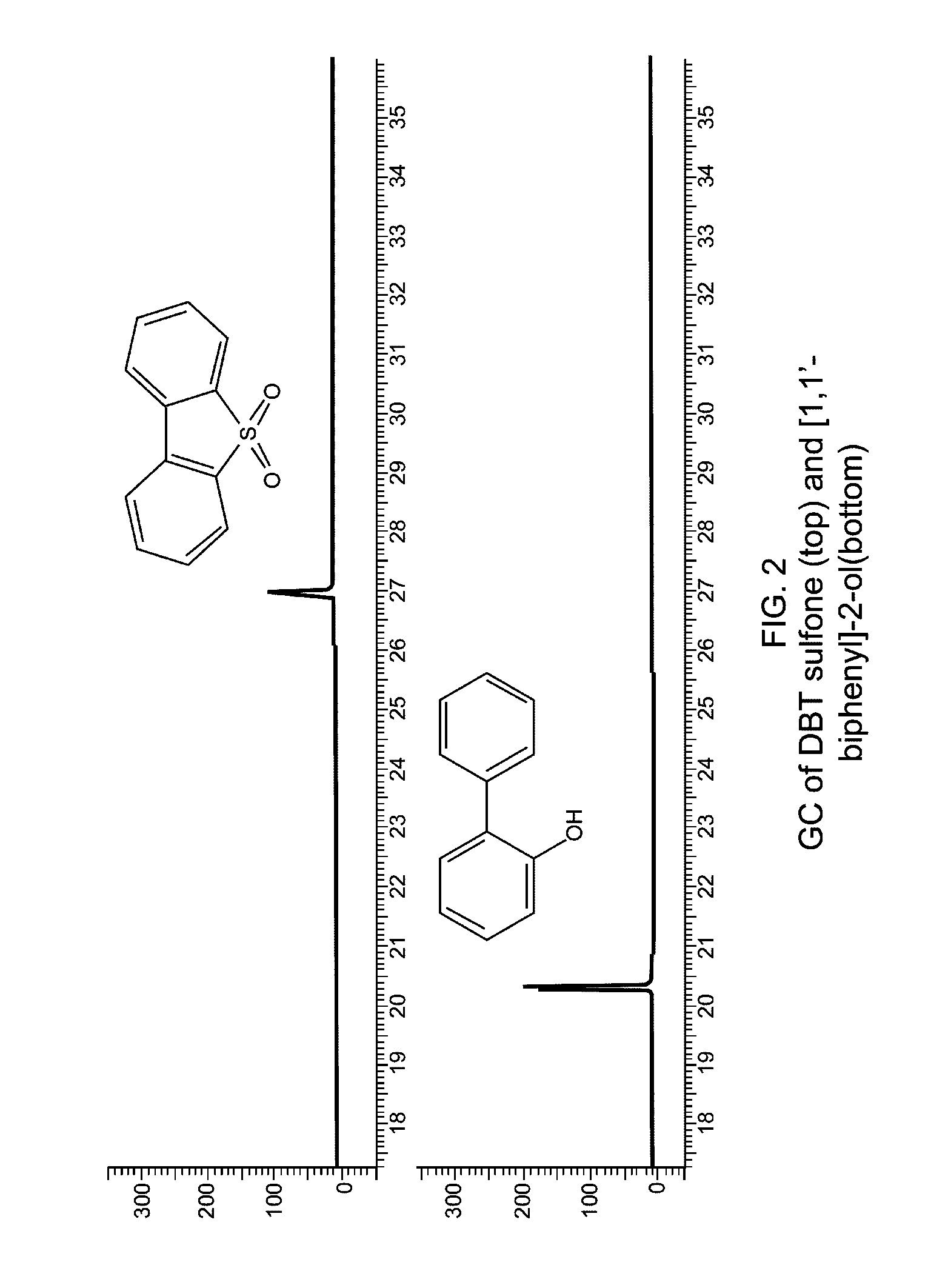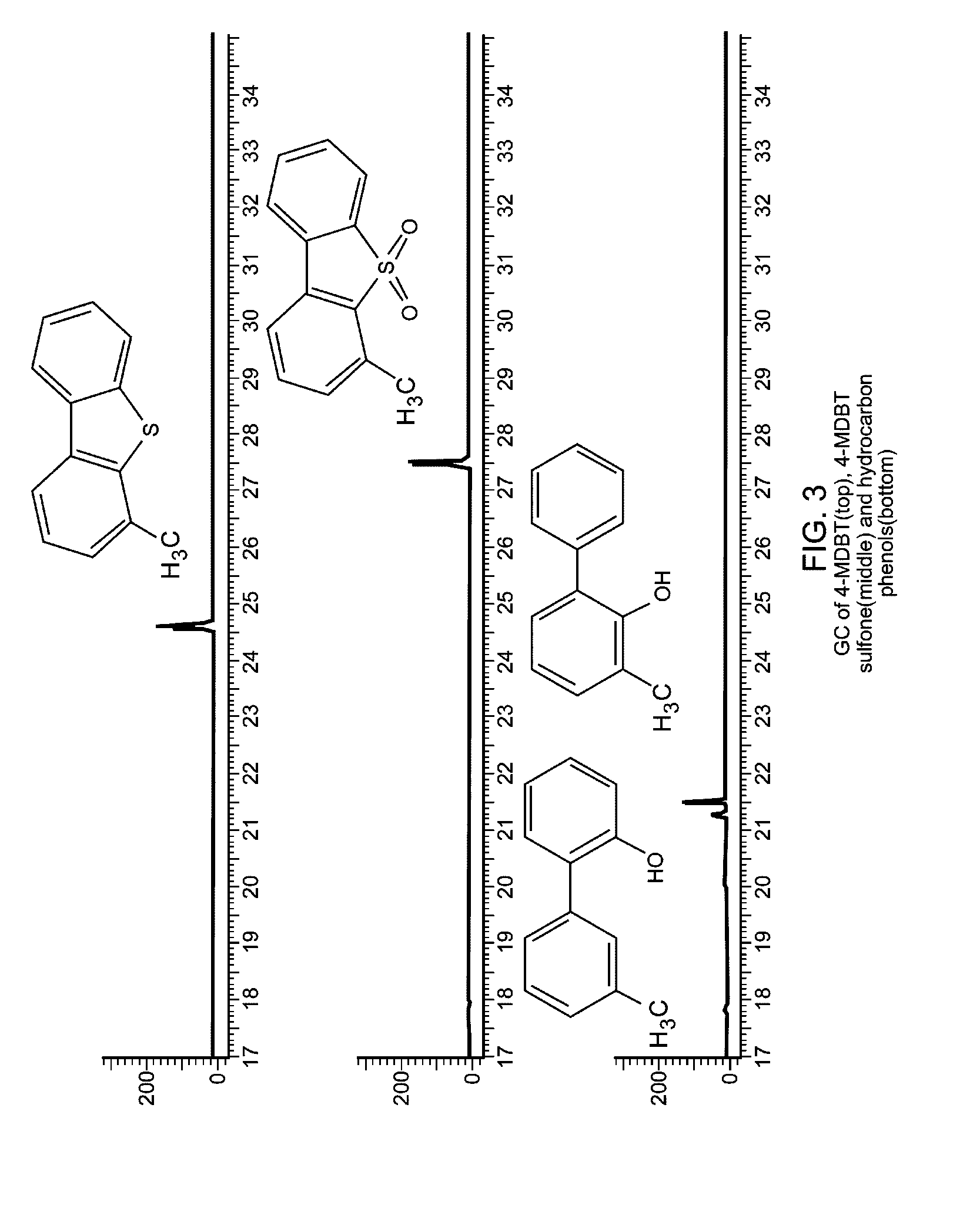Hydrocarbon recovery from sulfones formed by oxidative desulfurization process
a technology of desulfurization and hydrocarbon recovery, which is applied in the field of hydrocarbon recovery of sulfones formed by oxidative desulfurization, can solve the problems of limiting the applicability of this process, reducing the economic viability of removing the remainder of sulfur content, and reducing the yield of hydrocarbons in fuel oil products, so as to reduce the cost and ecological impact of solid waste disposal
- Summary
- Abstract
- Description
- Claims
- Application Information
AI Technical Summary
Benefits of technology
Problems solved by technology
Method used
Image
Examples
example 1
[0060]0.5 g of DBT sulfone (2.31 mmol), 0.4 g of NaOH (10 mmol) and 5 ml of H2O were added into a 10 ml autoclave and sealed. It was heated to 300° C. (5° C. / min) and dwelled for 1.5 h in a furnace. It was cooled to room temperature and opened with care. The colorless solution was removed by a pipette. The autoclave was washed with H2O. The collected solution was adjusted to pH˜7 using a dilute HCl solution. White solid was formed. The mixture was extracted by CH2Cl2. An organic layer was collected and dried by anhydrous Na2SO4. The filtration was evaporated to dryness to give 0.34 g (86.5% recovery) of white crystalline solid. GC spectrum (FIG. 2) indicated that the sulfone is completely decomposed and there is only one species in the decomposition product. GC-MS result confirmed that it is [1,1′-biphenyl]-2-ol (MW=170).
[0061][1,1′-biphenyl]-2-ol C12H10O, MW: 170.21. GC-MS: 171 (13.2%), 170 (100%), 169 (77.1%), 168 (14.8%), 142 (13.3%), 141 (42.6%), 139 (16.5%), 115 (39.8%), 70 (10...
example 2
[0071]The reaction for preparation of 4-MDBT sulfone is shown below:
[0072]
[0073]2 g of 4-MDBT (10.09 mmol) was dissolved in 80 ml of octane in a 250 ml round-bottomed flask. 100 mg of MoO3 and 10 ml of cumene hydroperoxide (54.14 mmol) were added. The mixture was heated to 100° C. for 5 h with magnetic stirring. After cooling down to room temperature, large amount of white solid was filtered and washed with hexane. The white solid was dried in air and then dissolved in CH2Cl2. The insoluble precipitation was filtered and washed with CH2Cl2. CH2Cl2 was evaporated to dryness to give 1.81 g (77.9%) of white crystalline solid. GC data (FIG. 3, middle) indicated that there is only one species. GC-MS result confirmed that it is 4-MDBT sulfone.
[0074]4-MDBT sulfone C13H10O2S, MW: 230.28. GC-MS: 230 (100%), 201 (29.5%), 187 (25.5%), 181 (36.1%), 165 (21.3%), 152 (20.5%), 139 (20.1%), 136 (29.3%), 115 (20.1%), 63 (19.1%).
[0075]The reaction for hydrocarbon recovery from 4-MDBT sulfone is shown...
example 3
[0084]The reaction for preparation of 4,6-MDBT sulfone is shown below:
[0085]
[0086]400 mg of 4,6-DMDBT (1.88 mmol), 25 ml of octane, 2 ml of CHP (10.8 mmol) and 40 mg of MoO3 (0.28 mmol) were added into a 100 ml of round-bottomed flask. It was heated to 100° C. for 5 h with magnetic stirring. After cooling down to room temperature, large amount of white solid was filtered and washed with hexane. The white crystalline solid was dried in air and then dissolved in CH2Cl2. The insoluble precipitation was filtered and washed with CH2Cl2. CH2Cl2 was evaporated to dryness to give 0.34 g of white crystalline solid. GC data (FIG. 4 middle) indicated that there are two species in the product. GC-MS result confirmed that the main peak is our expected product 4,6-DMDBT sulfone, and the small peak is incompletely oxidized product 4,6-dimethyldibenzothiophene-5-oxide.
[0087]4,6-dimethyldibenzothiophene sulfone C14H12SO2, MW: 244.31, GC-MS: 244 (100%), 215 (21.2%), 201 (39.7%), 195 (25.6%), 184 (15....
PUM
| Property | Measurement | Unit |
|---|---|---|
| temperature | aaaaa | aaaaa |
| temperature | aaaaa | aaaaa |
| reaction temperature | aaaaa | aaaaa |
Abstract
Description
Claims
Application Information
 Login to View More
Login to View More - R&D
- Intellectual Property
- Life Sciences
- Materials
- Tech Scout
- Unparalleled Data Quality
- Higher Quality Content
- 60% Fewer Hallucinations
Browse by: Latest US Patents, China's latest patents, Technical Efficacy Thesaurus, Application Domain, Technology Topic, Popular Technical Reports.
© 2025 PatSnap. All rights reserved.Legal|Privacy policy|Modern Slavery Act Transparency Statement|Sitemap|About US| Contact US: help@patsnap.com



